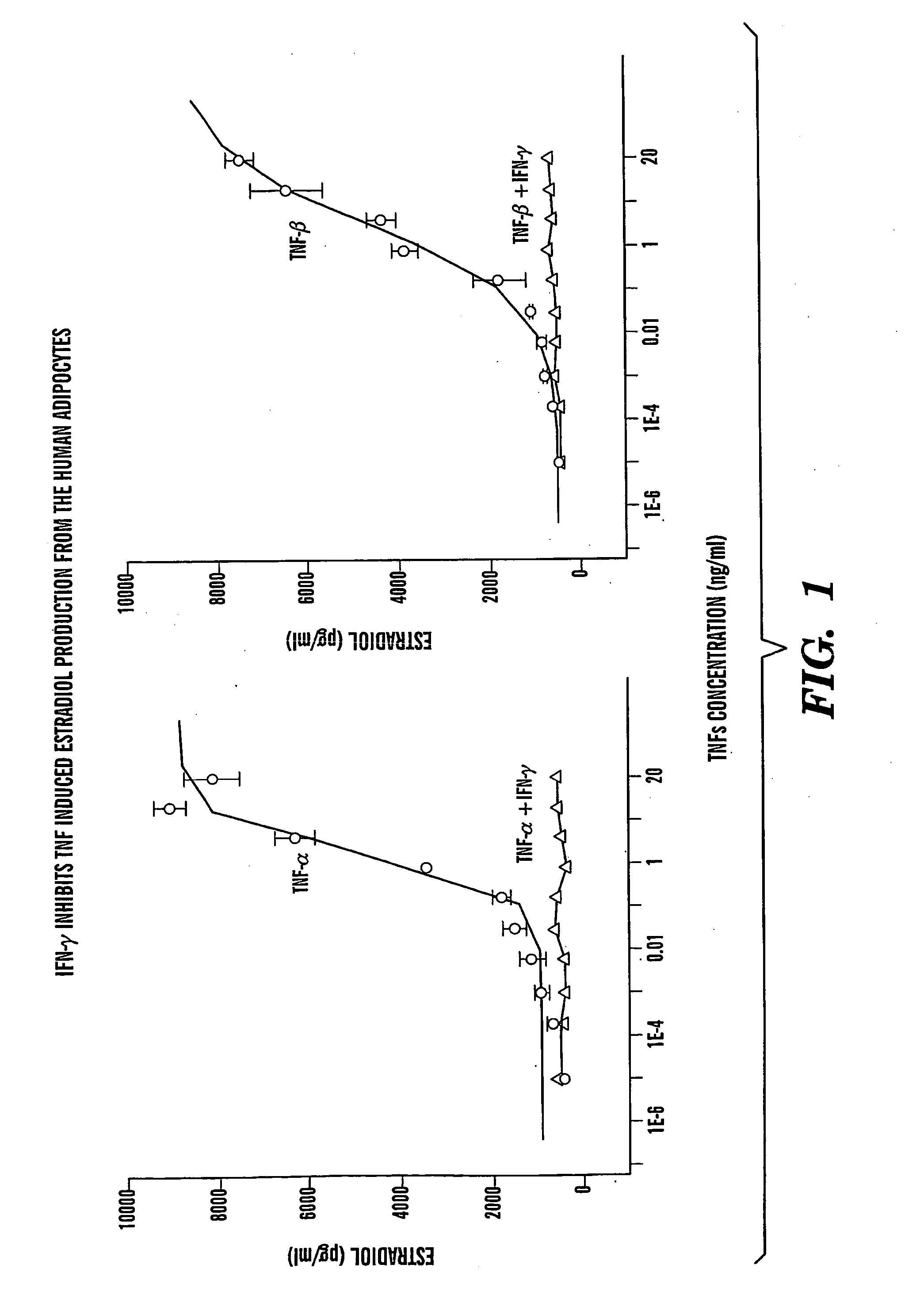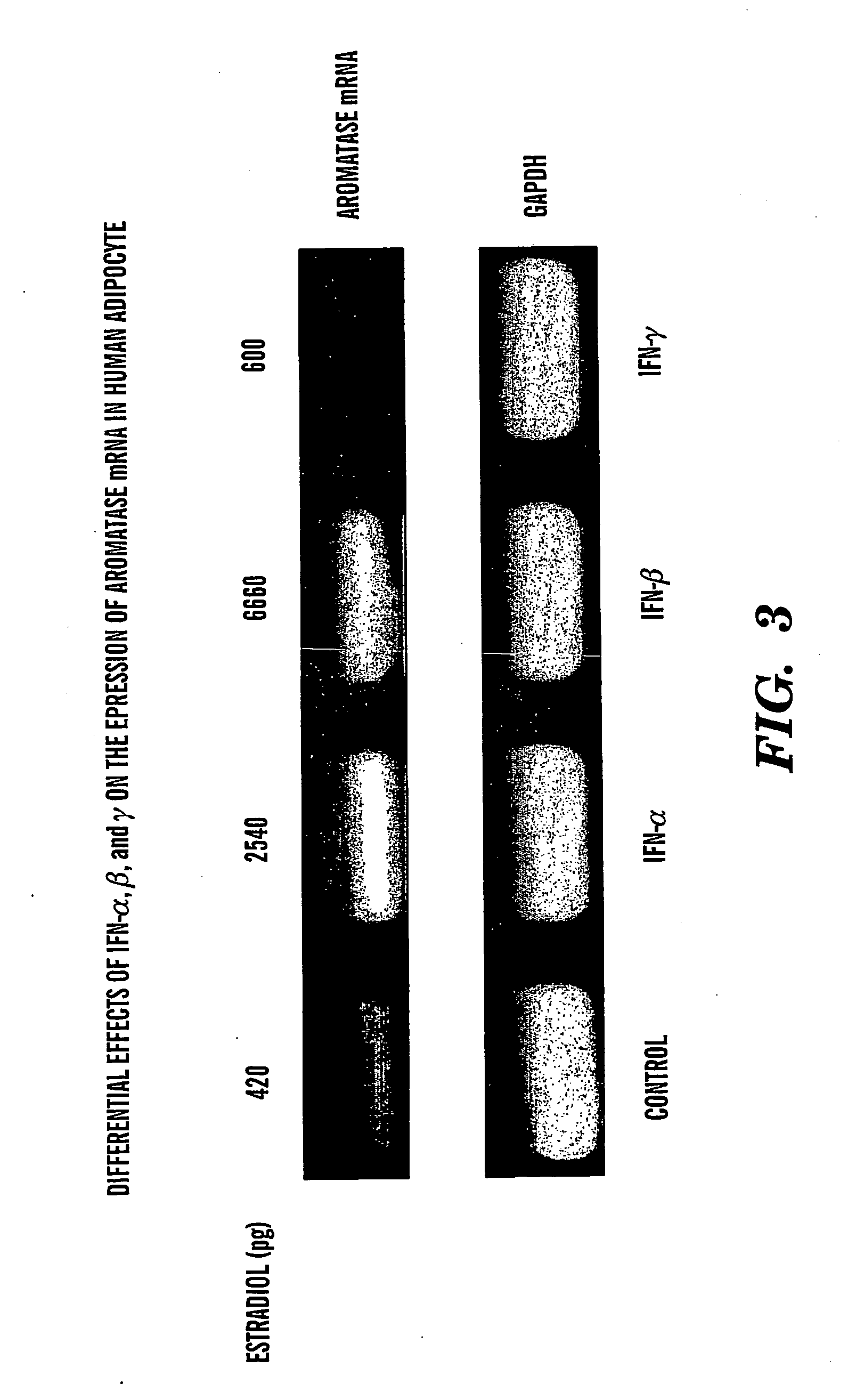Method of treating estrogen responsive breast cancer
a breast cancer and estrogen-responsive technology, applied in the field of treating estrogen-responsive breast cancer, can solve the problems of many problems associated with the quality of life, be counterproductive in some cases, and significant health problems of breast cancer, and achieve the effects of reducing estrogen levels, lowering estrogen levels, and inhibiting estradiol production
- Summary
- Abstract
- Description
- Claims
- Application Information
AI Technical Summary
Benefits of technology
Problems solved by technology
Method used
Image
Examples
example 1
[0064] Human subcutaneous cultured adipocytes and preadipocytes, catalog nos. SP-1012, SP-1024, SP-1096, SP-75, or SP-25 were purchased from Zen-Bio, Inc. (Research Triangle Park, N.C.) and cultured according to the manufacturer's instructions.
[0065] The culture medium of the preadipocytes was supplemented with 0.1 μg / ml IFN-γ and increasing concentrations of either TNF-α or TNF-β as shown in FIG. 1. Estradiol concentrations were measured using the Active™ Estradiol EIA kit according to the manufacturer's instructions (catalog no. DSL-10-4300, Diagnostic Systems Laboratories, Inc., Webster, Tex.). As indicated by filled ovals in FIG. 1, both TNF-α and INF-β, significantly increased estradiol amount. However, when IFN-γ was given to the cells, the filled triangles show that interferon gamma (IFN-γ) inhibits tumor necrosis factor alfa (TNF-α) and tumor necrosis factor beta (TNF-β) induced estradiol production in human adipocytes.
example 2
[0066] Adipocyte cultures were treated with IL-1-β, IFN-γ, TNF-α, and combinations of IL-1-β and IFN-γ and TNF-α and IFN-γ. Consequently, total RNA from cultured adipocytes was isolated using conventional methods. The reverse transcriptase polymerase chain reaction (RT-PCR) was performed using aromatase specific primers. The amplified aromatase cDNA fragments produced by RT-PCR were separated on an agarose gel. As shown in the FIG. 2, IL-1β and TNF-α alone induced transcription of aromatase mRNA compared to untreated control. However, the administration of IFN-γ inhibits the transcription of aromatase mRNA when given together with IL-1β or TNFα. The lower panel shows transcription of a constitutively expressed household gene, glyceraldehyde-phosphate dehydrogenase (GAPDH). Control lane shows the base level of aromatase mRNA expression in adipocytes. The estradiol production by the cells is shown as pikograms / ml (pg / ml) below the photograph of the gel showing the aromatase mRNA level...
example 3
[0067] The isolated human adipocytes were also treated with different interferon family members: IFN-α, -β, and -γ. As shown in FIG. 3, the expression of aromatase MRNA in human adipocytes was significantly increased by addition of IFN-α and -β whereas IFN-γ inhibits the endogenous aromatase MRNA expression. The estradiol production increased by about 6 fold upon IFN-A induction and by about 16 fold upon IFN-β induction (shown in pg estradiol / ml of culture medium above the gel photograph showing the aromatase mRNA levels).
PUM
| Property | Measurement | Unit |
|---|---|---|
| Responsivity | aaaaa | aaaaa |
Abstract
Description
Claims
Application Information
 Login to View More
Login to View More - R&D
- Intellectual Property
- Life Sciences
- Materials
- Tech Scout
- Unparalleled Data Quality
- Higher Quality Content
- 60% Fewer Hallucinations
Browse by: Latest US Patents, China's latest patents, Technical Efficacy Thesaurus, Application Domain, Technology Topic, Popular Technical Reports.
© 2025 PatSnap. All rights reserved.Legal|Privacy policy|Modern Slavery Act Transparency Statement|Sitemap|About US| Contact US: help@patsnap.com



